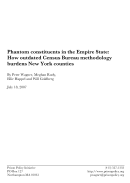
Importing Constituents:
Prisoners and Political Clout in Wisconsin
By John Hejduk and Peter Wagner
Prison Policy Initiative
March 2008
Section:
III. Redistricting and “One Person, One Vote”
The basic principle of American representative democracy is that every vote must be of equal weight. When governments draw districts with equal populations, they ensure that each resident has equal access to government, no matter where she or he lives. When districts are of substantially different sizes, the weight of each vote starts to differ: in underpopulated districts, each vote is worth more, and in overpopulated districts, a vote is worth less.
The U.S. Supreme Court first declared that the “One Person, One Vote” principle applied to state legislative redistricting in the 1963 landmark case Reynolds v. Sims.[9] The Court struck down an apportionment scheme for the Alabama state legislature that was based on counties and not population. In 1960 Alabama, Lowndes County, with 15,417 people, had the same number of state senators as Jefferson County, with 634,864 people, giving the residents of sparsely-populated Lowndes County 41 times as much political power as the residents of densely-populated Jefferson County. The Supreme Court ruled that the 14th Amendment’s equal protection clause required that districts be drawn to be substantially equal in population.
Subsequent U.S. Supreme Court cases defined the limits of “substantially equal.” In White v. Regester, the Court ruled that the State of Texas was not required to justify how it drew lines resulting in an average district deviation of less than 2% and a maximum deviation of 9.9%.[10] Today, most states draw their districts so that the smallest district is no more than 5% smaller, and the largest no more than 5% larger, than the average district. This keeps the difference between the largest and smallest district within 10%.
Wisconsin has historically applied a much higher standard, drawing districts with a maximum deviation of less than 2%. Only four states currently have districts that are more equal in population than Wisconsin’s.[11] For three decades, federal judges have drawn the state Assembly and Senate legislative district maps. In 1982, at the first redistricting since the U.S. Supreme Court allowed Texas to have a population deviation of 10%, the federal judges who drew Wisconsin’s districts set a higher standard, explaining that “We believe that a constitutionally acceptable plan should not deviate as high as 10%, and should, if possible, be kept below 2%.”[12] The plan they drafted met even that high standard: “The deviation in our plan is a scant 1.74%.”[13]
In 1992, the court drew a plan with an even smaller total deviation from exact population equality: 0.52%.[14] In 2002, the court drew a plan with a deviation of only 1.48%, still within the 2% threshold established in 1982.[15]
Wisconsin rightly prioritizes population equality when drawing districts, but the Census Bureau has undermined these efforts by crediting thousands of prisoners to the wrong place.
Footnotes
[8] This last figure is doubly ironic because the prison facility isn’t even in Marquette. The Census mistakenly counted Oxford Prison at its postal address in Marquette County, when it actually is in neighboring Adams County. (The published Census figures were used for state redistricting and remain the official numbers for most purposes, but the distortion would be almost the same if the prison had been counted in the right place. The Census Count Question Resolution program states that Adams County has 19,920 people, of whom 6.4% are incarcerated.)
[9] Reynolds v. Sims, 377 US 533 (1964).
[10] White v. Regester, 412 U.S. 755 (1973).
[11] Illinois, California, Washington and Minnesota drew more equal House districts, and Illinois, California, Florida and Washington drew more equal Senate districts. National Conference Of State Legislators, Redistricting 2000 Population Deviation Table, (visited August 8th, 2007)
[12] AFL-CIO v. Elections Bd., 543 F. Supp. at 634 (E.D. Wis. 1982).
[13] AFL-CIO at 637.
[14] Prosser v. Elections Bd., 793 F.Supp. 859, 870 (W.D. Wis. 1992).
[15] Baumgart v. Wendelberger, (2002). Wendelberger Slip Copy, 2002 WL 34127471 at 8. Also available at http://web.archive.org/web/20100601174355/http://legis.wisconsin.gov/ltsb/redistricting/PDFs/decision.pdf
Events
- April 15-17, 2025:
Sarah Staudt, our Director of Policy and Advocacy, will be attending the MacArthur Safety and Justice Challenge Network Meeting from April 15-17 in Chicago. Drop her a line if you’d like to meet up!
Not near you?
Invite us to your city, college or organization.



